#woolner brothers pictures
Explore tagged Tumblr posts
Text
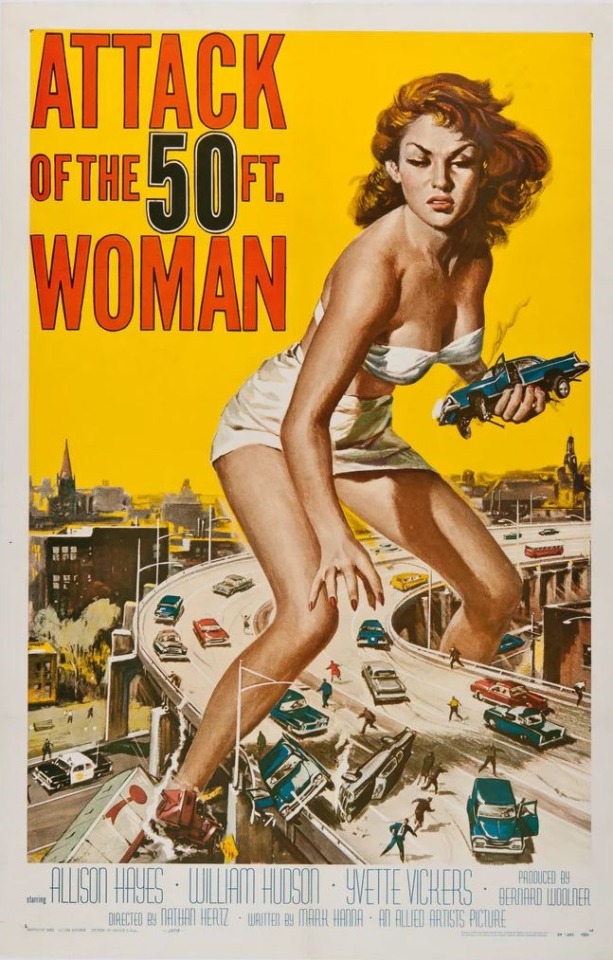
Movie poster by Reynold Brown for the 1958 Woolner Brothers motion picture Attack of the 50 ft. Woman. The movie was distributed by Allied Artists Pictures Corporation who later produced a television version that was nine minutes longer.
#movie poster#Attack of the 50 ft. Woman#Reynold Brown#Woolner Brothers Pictures#Allied Artists Pictures#1958 movies
4 notes
·
View notes
Text
Red-Dragon 22x28 Movie Poster (1967)

Woolier Brothers Pictures
#poster collector 1975#red-dragon#woolner brothers pictures#stewart granger#rosanna schiaffino#suzanne roquette#movie poster#promotional posters
1 note
·
View note
Link
Fanny Eaton appears in a picture that hangs in Tate Britain. Dante Gabriel Rossetti painted that one. She’s also in a painting by John Everett Millais at the National Museum Wales. There are many paintings of Fanny and, although her occupation was often given as ‘charwoman’, she was Britain’s most visible Victorian woman of colour and an icon of mixed heritage beauty.
She was born Fanny Antwistle, or possibly Entwhistle, in 1835 in Surrey, Jamaica. Her mother, Matilda Foster, was a slave who got her freedom after abolition in 1834, and her father was white. In the 1840s – the beginning of Queen Victoria’s reign, a time of gas lamps and Dickens – Fanny and her mother travelled to London.
In 1857, she married James Eaton, a cab driver. Fanny worked as a cleaner in between having 10 children, but she also had a side hustle a world away from household drudgery.
In her twenties, Fanny was a model at the Royal Academy of Art. This is how she came to the attention of the Pre-Raphaelites – in the 1840s, Millais and William Holman Hunt were students there, and in 1848 they, along with Rossetti, his brother William, Ford Madox Brown, James Collinson, Frederic Stephens, and Thomas Woolner, formed the Pre-Raphaelite Brotherhood. They enjoyed wafting about town, taking laudanum (an addictive painkiller) and declaiming their ideas about ‘real’ art.
Why was she a trailblazer?
Fanny made women of colour visible at a time when they were elsewhere invisible. Pictures of her hung in galleries across the country, her image was reproduced and she was held up as an example of perfect beauty. That she was a Pre-Raphaelite muse has ensured her name endures.
Though many of the muses were working class women, all were transformed into creatures of myth and legend at the stroke of a brush and several others became well known for their beauty.
But Fanny had something none of the others had: dark skin – rare in art of the time and precious to a group of artists trying to stand out.
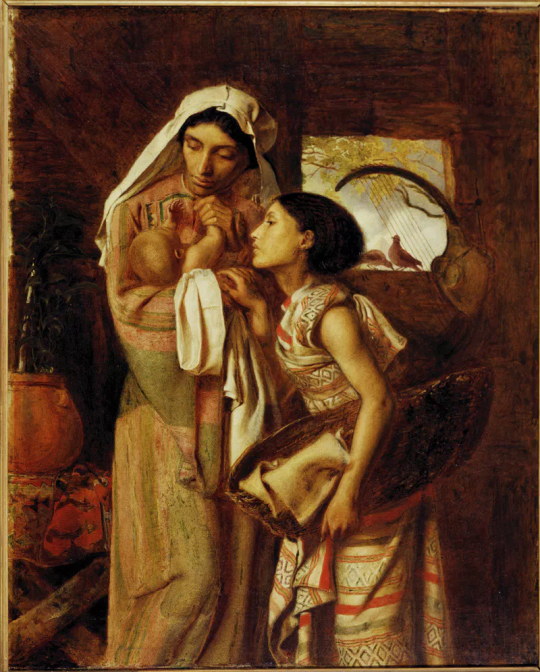
Fanny first appears in Simeon Solomon’s religious scene, The Mother Of Moses, exhibited at the Royal Academy in 1860. Solomon’s pencil study for the work shows Fanny’s striking beauty and natural textured hair. Joanna Boyce Wells’s The Head Of Mrs Eaton (1861) shows her in classical garb exhibiting her beautiful profile.
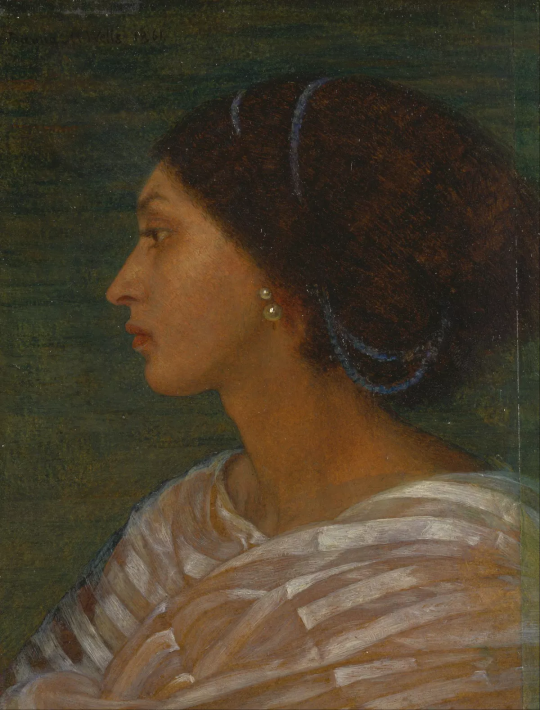
Several others depicted Fanny, and by 1865 Rossetti had got in on the act with The Beloved. He wrote to his friend Brown, enthusing about Fanny’s “very fine head and figure”. In 1867 Fanny sat for Millais – his Jephthah is the last known painting of her.
By age 63, Fanny was on the Isle of Wight working as a domestic cook. She returned to London to live with her children and grandchildren, where she died at 88, immortalised on canvas forever.
I love that Millais and Solomon used Eaton in Biblical scenes, reminding Victorian viewers that people in the Bible came in many colors. But my favorite is the portrait by Joanna Boyce Wells. She paints her as like an upperclass woman, in a fine fabric shawl and with her hair dressed and pearl earrings. She painted her like an equal to the white women whose rich husbands commissioned portraits of them.
221 notes
·
View notes
Quote
The two Rossettis (brothers they) And Holman Hunt and John Millais, With Stephens chivalrous and bland, And Woolner in a distant land — In these six men I awestruck see Embodied the great P.R.B. D. G. Rossetti offered two Good pictures to the public view; Unnumbered ones great John Millais, And Holman more than I can say William Rossetti calm and solemn Cuts up his brethren by the column.
Christina Rossetti, The P.R.B. (I)
#1853#19th century#christina rossetti#art#poetry#the P.R.B.#PRB poetry#pre raphaelite poetry#pre raphaelite brotherhood
55 notes
·
View notes
Text
Pre - Raphaelites
Pre-Raphaelite Brotherhood, group of young British painters who banded together in 1848 in reaction against what they conceived to be the unimaginative and artificial historical painting of the Royal Academy and who purportedly sought to express a new moral seriousness and sincerity in their works. They were inspired by Italian art of the 14th and 15th centuries, and their adoption of the name Pre-Raphaelite expressed their admiration for what they saw as the direct and uncomplicated depiction of nature typical of Italian painting before the High Renaissance and, particularly, before the time of Raphael.
Back then most people thought the best painter of all time was the Italian painter Raphael. Raphael was painting nearly 400 years before the Pre-Raphaelites. He liked creating epic religious paintings of Jesus’s life. Raphael imagined these scenes to be very beautiful. The Pre-Raphaelites didn’t like this and wanted to paint what they knew. This is how they got their name. It literally means before Raphael.
The Creation of Eve from Adam (c. 1499), by Raphael. Raphael did some beautiful artwork but I can see the difference between his artwork and the artwork from the Pre-Raphaelite Brotherhood.

Resurrection of Christ (1499–1502), by Raphael

The Brotherhood was formed by three Royal Academy students: Dante Gabriel Rossetti, who was a gifted poet as well as a painter, William Holman Hunt, and John Everett Millais, all under 25 years of age. The painter James Collinson, the painter and critic F.G. Stephens, the sculptor Thomas Woolner, and the critic William Michael Rossetti (Dante Gabriel’s brother) joined them by invitation. The painters William Dyce and Ford Madox Brown, who acted in part as mentors to the younger men, came to adapt their own work to the Pre-Raphaelite style.
Their pictures of religious and medieval subjects strove to revive the deep religious feeling and naive, unadorned directness of 15th-century Florentine and Sienese painting. The style that Hunt and Millais evolved featured sharp and brilliant lighting, a clear atmosphere, and a near-photographic reproduction of minute details. They also frequently introduced a private poetic symbolism into their representations of biblical subjects and medieval literary themes. Rossetti’s work differed from that of the others in its more arcane aesthetic and in the artist’s general lack of interest in copying the precise appearance of objects in nature. Vitality and freshness of vision are the most admirable qualities of these early Pre-Raphaelite paintings.
Some of the founding members exhibited their first works anonymously, signing their paintings with the monogram PRB. When their identity and youth were discovered in 1850, their work was harshly criticized by the novelist Charles Dickens, among others, not only for its disregard of academic ideals of beauty but also for its apparent irreverence in treating religious themes with an uncompromising realism. Nevertheless, the leading art critic of the day, John Ruskin, stoutly defended Pre-Raphaelite art, and the members of the group were never without patrons.
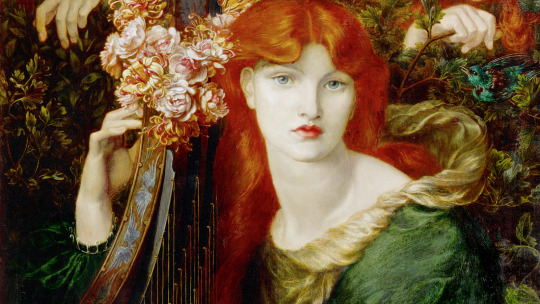
I have attached quite a lot of paintings in this post because I think those paintings are extremely beautiful! I love the style and the atmospheric feeling!
Holman Hunt is one of the founders of the Pre- Raphaelite Brotherhood. His paintings were notable for their great attention to detail, vivid colour, and elaborate symbolism. The painting below is painted by him and is called The Hireling Shepherd (1851)
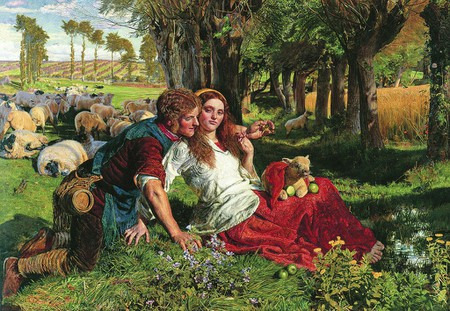
May Morning on Magdalen Tower (1890), also painted by Holman Hunt.
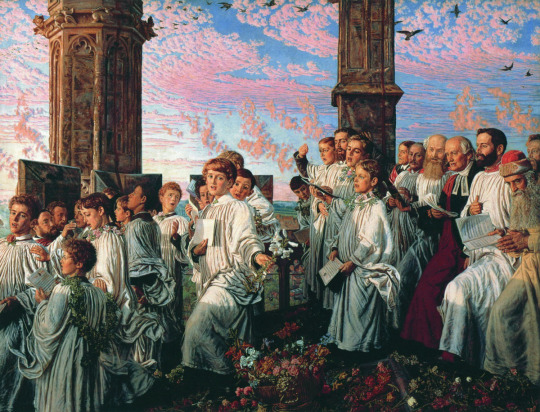
This painting here is called The Lady Of Shalott (1888) and was painted by John William Waterhouse who worked first in the academic style and then joined the pre - raphaelites. I really like his artworks!
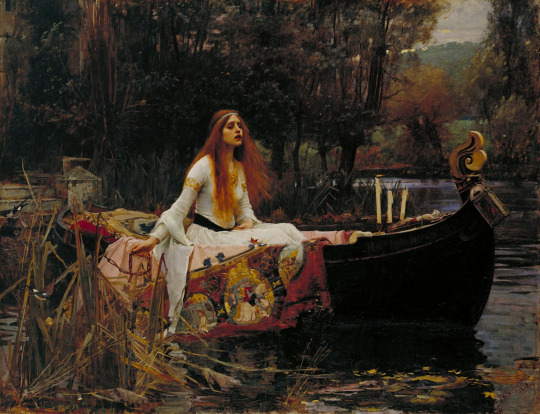
Ophelia (1889), also painted by John William Waterhouse

0 notes
Text
Journal Task Week 5
Week 5: History: Methodical Contextualisation Task: what does historical research mean and how can it change our understanding of an image?
Today we looked at history as a field and as a methodology. History is often seen as a linear narrative, based in truth, but the reality is far more complex. In the quote from David Bates (below) he talks about how a photograph is produced within a context; the decisions the photographer makes about how he takes that image whether he is making conscious decisions or not will effect how the final image looks.
“All photographs are produced within a context. A photographer works with materials (camera, computer, prints etc.) within a definite social place and time. These materials and the choices the photographer exercises over them, whether conscious or not (i.e., not ‘thinking about it’) organizes the look of the picture”.
(Bate, D. 2009, p.16.)
As a field the history of photography and art can be investigated by looking at: Individual practitioners (their lives and works, who worked with whom, when and where, how and why they did what they did). Periods (what kind of work was created during a specified time period). Styles (how styles interacted with each other – what influence what/whom). Movements (how movements came and went, how they interacted with each other) Using history as field we can ask certain question:
What happened? - a descriptive account
Why did it happen?
How was it possible that it did happen?
Why an individual/set of individuals acted in a certain way. (Seeking to explain individuals’ intentions, motivations, influences etc)
What exactly happened in this historical period
By answering these questions this would lead me into using history as method. I would do this by going to the library, looking at archives, etc. Historical research cannot be achieved by googling, proper research needs to be done.
Examples of how a historical understanding of a picture can change the way we think about it:

Apollo 11, view of Earth rising above Moon’s horizon
When we first look at this picture we can see the view of the earth from the moon. When looking at the historical context in which the picture was taken, we see it against a backdrop of the Cold War; The Cuban missile crisis; The Vietnam War and the arms war, Earth rise becomes a stark remind of Earth’s vulnerability. 'Our planet is a lonely speck in the great enveloping cosmic dark,' the US astronomer, Carl Sagan, noted. 'There is no hint that help will come from elsewhere to save us from ourselves.' UK space historian Robert Poole says ‘ the first popular expressions of ecological concern can be traced to the publication of that picture: dazzling blue ocean, the jacket of cloud and the relative invisibility of the land and human settlement’. 'It is a rebuke to the vanity of humankind,' says Poole. 'Earthrise was an epiphany in space’. It has become one of history’s most influential images.
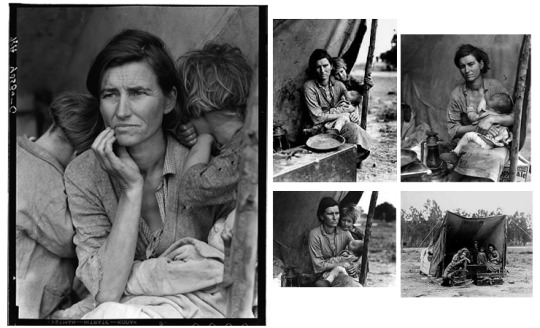
Migrant Mother, taken by Dorothea Lange in 1936
Another example is Dorothea Lange Migrant Mother (2),1936. This image was taken by Lange who was part of the FSA (The Farm Security Administration), The FSA included other photographers and their task was to capture images to help combat rural poverty in the Great Depression.The photo was circulated in newspapers across the nation and became a symbol for strength in difficult times. The government responded by sending 20,000 pounds of food to the camp. By understanding the historical context in which the picture was taken we have a deeper understanding of the image.
Below are two images by Julia Margaret Cameron. I have recently rediscovered her work in this semesters lectures. I am fascinated by the history/stories behind both Julia Cameron and her equally interesting models. There is so much research you could do into her photography using history as your methodology. I have included some information I have found on Mrs Herbert Duckworth, and also on Alice Liddell who has the Lewis Carol connection, and is thought to be the ‘Alice’ in Alice in Wonder Land book. I would like to see the images at The Victoria & Albert Museum, and have the opportunity to do some proper historical research into Julia Margaret Cameron.
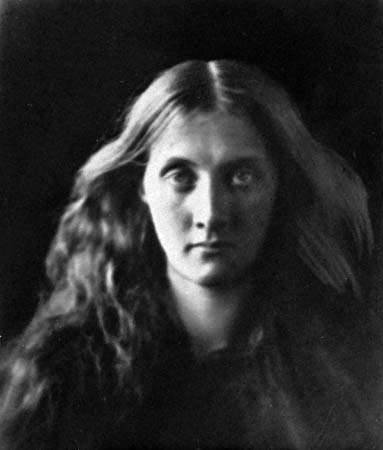
Mrs. Herbert Duckworth, (1867), by Julia Margaret Cameron
INFORMATION TAKEN FROM THE JOHN PAUL GETTY MUSEUM:
Mrs Herbert Duckworth (née Julia Jackson, 1846-1895) was widely regarded as the most attractive of all the daughters born to the Pattle sisters. She was the child of Mia, Julia Margaret Cameron’s youngest sister, and her husband John Jackson, a physician who practiced for twenty-five years in Calcutta. Her beauty prompted several proposals of marriage, most notably from William Holman Hunt and the sculptor Thomas Woolner. She was continually sought after as a model by leading artists of the day: George Frederick Watts drew her often during childhood and painted her portrait in oil in 1874; Edward Burne-Jones used her as the model for the Virgin in his Annunciation (1879), one of the great works of Pre-Raphaelite painting. Cameron photographed her treasured namesake, niece, and godchild repeatedly over the years, creating a corpus of works that are among the finest examples of her work.
In 1867, at the age of twenty-one, Jackson accepted the marriage proposal of Herbert Duckworth (1833-1870), a barrister. This striking portrait and another, probably made just prior to her wedding, project an image of heroic womanhood and celebrate her cool, Puritan beauty. The perfect framing of the bust in both is given great emphasis by Cameron’s handling of light, which is carefully cast to accentuate the strength and beauty of the head. This is the most revolutionary aspect of these pictures and is akin to the attention and quality of effort Cameron expended on her images of famous men.
Duckworth was widowed in 1870 after only three years of marriage. Mourning the loss of her husband she took up studies on agnosticism and also began to nurse the ill and dying. In this period she came to know Leslie Stephen (1832-1904), an author on the subject of agnosticism and the brother-in-law of her friend Anne Thackeray. After his wife Minnie died in 1875, Stephen and Duckworth grew even closer eventually marrying in 1878. They went on to have four children, including the artist Vanessa Bell and the author Virginia Woolf. Woolf described her mother in the character of Mrs. Ramsay in To the Lighthouse (1927): “The Graces assembling seemed to have joined hands in meadows of asphodel to compose that face.” Cameron’s 1872 portrait of Duckworth seems to echo this description with its subtitle, “A Beautiful Vision” (

Pomona1872
Julia Margaret Cameron British
Alice Liddell (1852–1934)—who, as a child, was Lewis Carroll’s muse and frequent photographic model—posed for Cameron a dozen times in August and September 1872. Against a dense background of foliage and bedecked with flowers, the twenty-year-old Liddell was photographed by Cameron as the embodiment of fruitful abundance, Pomona, Roman goddess of gardens and fruit trees.
INFORMATION TAKEN FROM THE V&A
0 notes